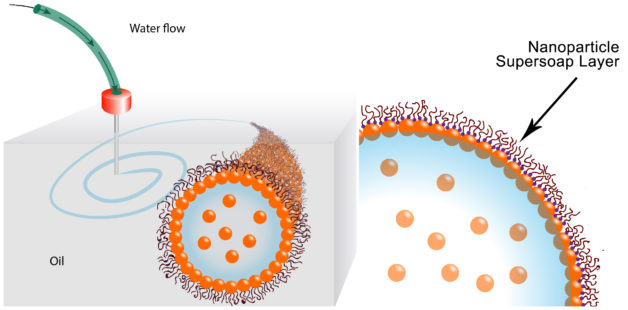Mesmerizing 'Self-Healing' Liquid Sculptures Hold Their Shape: How It Works
A mesmerizing new video shows scientists crafting dazzling, slinky-like sculptures made completely out of liquid — and the liquid structures can hold their shape for months.
Researchers created the ghostly-looking sculptures by manipulating the properties of water and oil. Anyone who has ever tried to make salad dressing knows oil and water normally don't mix; their molecules are simply more attracted to their own kind than to each other — unless, of course, you use a substance like mustard that can bring the sides together.
When you do that, you can make oil and water stick together in solution, said Joe Forth, a researcher at the Lawrence Berkeley National Laboratory in California. "But you can't make complex structures. In fact, you can only ever make a sphere." [The Mysterious Physics of 7 Everyday Things]
Forth and his team have created structures far more interesting than spheres that suggest a stunning new way to think of technology.
"You can change their shape basically as much as you want as long as you do it gently enough," Forth told Live Science.
When oil and water mix, the oil either glops at the bottom or forms a slick on top. An emulsifier — like mustard or soap — stabilizes the two and allows oil (such as that in dirt on your hands) to mix with water (like that coming from the faucet on your sink).

So the scientists created their own "supersoap." They added tiny gold nanoparticles to the water, and to the oil, they added a ligand — a chemical that specializes in bonding to negatively charged material, like metal. The oil and water stayed separate, but the ligands and gold-laced water formed a glass-like barrier between the two liquids that allowed the water to take whatever shape the researchers wanted — and hold those forms for months at a time.
Sign up for the Live Science daily newsletter now
Get the world’s most fascinating discoveries delivered straight to your inbox.
"They are self-healing," Tom Russell, a visiting scientist at the lab and the lead investigator, told Live Science. "If you puncture it with, say, a needle that makes a hole, that hole will be healed."
Once the team mastered the basic science, they used a modified 3D printer to create spirals, tree-like branches, lattices and even threads thinner than a human hair.
Aside from being hypnotic to watch, these creations could facilitate interesting new technologies. Because the water is conductive, it could become a type of flexible liquid electrical cable. Or perhaps a chemical syringe that injects specific molecules into an ongoing liquid chemical reaction. Or even a liquid battery.
What's more, water conducts both ions and electrons, while oil can store energy — two necessary properties of electrical circuits, Russell said. "We could make all-liquid circuits. That's not far-reaching at all."
Originally published on Live Science.









